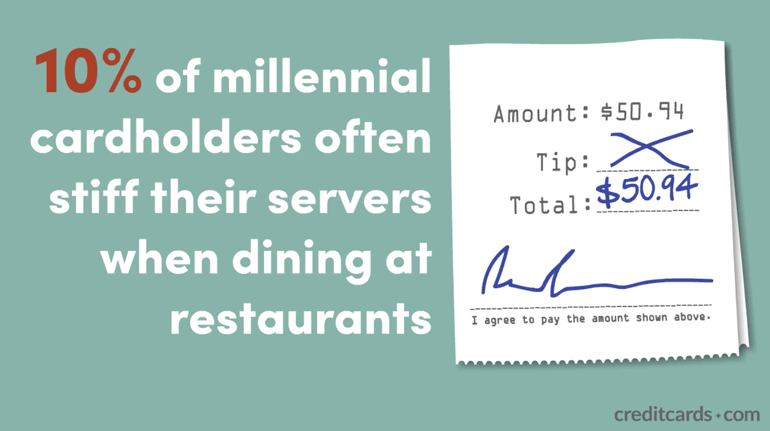Millennial patrons tend to tip less than their older counterparts, according to a new survey by CreditCards.com, and a tenth of them tip nothing at all.
About 10 percent of those Millennial customers, aged 18 to 37, usually leave nothing for a restaurant server compared to 3 percent of older patrons, according to a May survey by the Austin, Texas-based credit-card marketplace division of Bankrate Inc.
This study looked at tipping across all restaurant segments, including food trucks and coffee shops, and outside industries like taxis and rideshares.
“Tipping can be tricky and awkward because there’s really no right or wrong answer," said Matt Schulz, CreditCards.com senior industry analyst, in a statement.
"However, the truth is that many workers rely on tips to generate a large portion of their income,” he said. “To them, it’s not just about etiquette. It’s about being able to provide for their families and put food on their own tables.”

The May survey also found 63 percent of Millennials usually tip less than 20 percent at restaurants. Less than half those age 38 or older tip below that amount.
Other survey findings suggest older Americans and women are more generous tippers
- About 55 percent of consumers age 65 and older said they tip 20 percent or more at restaurants, the highest of any age groups. About 35 percent of people under 30 reported tipping at that level.
- The median tip from women is 20 percent, compared a median of 16 percent from men.
- 13 percent of whites said they typically tip less than 15 percent, compared with 48 percent of blacks and 36 percent of Hispanics.
- Regionally, diners in the South and West tend to tip less than other regions, and Southern customers are most likely of all, at 7 percent, to stiff servers and wait staff.
- Married people tip more than singles, and those with higher incomes and college degrees are bigger tippers.
When given a choice of pre-entered tipping options, 14 percent of Millennials pick the lowest category, twice as many as those who are older.
Many restaurant operators have given thought to or tested “service include” no-tipping options, but they are still wrestling with how to make the European model work in the United States.
Danny Meyer, founder and CEO of New York-based Union Square Hospitality Group LLC, told the Global Best Practices conference in February that eliminating tipping at some of his restaurants several years ago helped narrow the pay discrepancy between front-of-house and back of house workers. USHG deployed the model at such restaurants as The Modern, Union Square Cafe, Gramercy Tavern, Maialino, North End Grill, Café 2, Marta and Daily Provisions.
However, Meyer said some front-of-house employees were not thrilled with the no-tipping policy.
“We lost, of our legacy front-of-the-house staff, probably about 30 to 40 percent over a period of time,” he said. “The great thing is that the people who came in to take those jobs understand ‘hospitality included’ and are thrilled about it. They are doing the job because it is a profession.”
The CreditCards.com survey indicated younger customers may be embracing the no-tipping model, industry analyst Schulz said.
“We’re seeing younger adults tipping less,” he said, “and even showing a greater preference toward eliminating tipping altogether, even if it means paying more on the bill."
More than one-quarter (27 percent) of Millennials, including 30 percent of those aged 18 to 27, would prefer to pay more for food at restaurants in lieu of leaving a tip, the survey found.
That no-tipping sentiment was shared by one in four Gen Xers, those aged 38 to 53, the survey found.
Older respondents still share the current tipping mores. Only 13 percent of Baby Boomers (aged 54-72) and 18 percent of those older prefer higher food prices and no tipping.
The survey was conducted May 18-10 with 1,000 completed online interviews with adults, weighted to represent the general population. The margin of error was plus or minus 3 percentage points.
Contact Ron Ruggless at [email protected]
Follow him on Twitter: @RonRuggless





